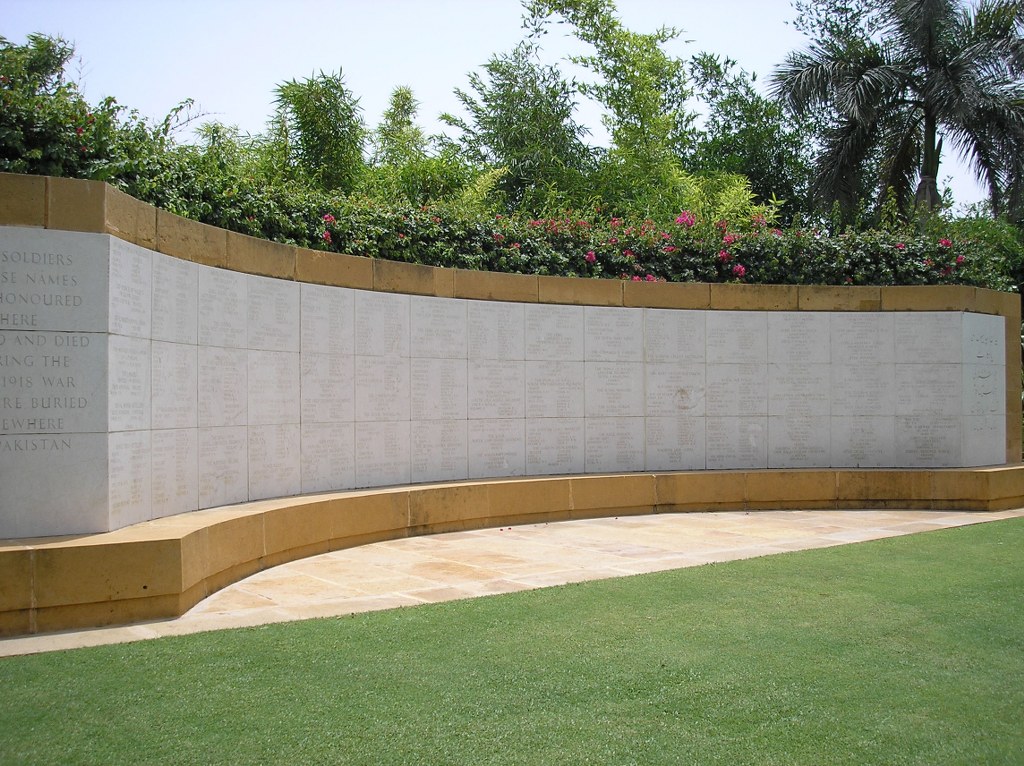Karachi 1914-1918 War Memorial
- Country Pakistan
- Total identified casualties 576 Find these casualties
- Identified casualties from First World War
- GPS Coordinates Latitude: 24.89434, Longitude: 67.0912
Location information
Karachi War Cemetery lies a few miles from the centre of Karachi, to the north-east on National Stadium Road and can be reached by taxi. It is now surrounded by the naval colony and is adjacent to the new naval cemetery. The easiest way to reach the War Cemetery from the city centre is to go the the National Stadium and follow the road leading to Dalmia in which the airport is situated. From the airport follow the reverse road from Dalmia to the National Stadium and the Cemetery is situated to the left hand side of National Stadium Road. Owing to constant problems the direction signs have been removed but attempts will be made at resiting them.
Visiting information
ARRIVAL
The route to the cemetery is signposted.
PARKING
There is a car park area directly in front of the cemetery.
Changes in level from the main road surface means there is a level difference between the main road and the parking area and may not be suitable for smaller vehicles.
A more accessible parking area is close to the marketplace, approximately 30 metres east of the main entrance to the cemetery.
ACCESS, LAYOUT AND MAIN ENTRANCE
The cemetery is a rectangular shape and located at the side of a main road.
There is a drop of approximately 300 mm from the main road, across gravel and concrete kerbing down to a concrete pavement in front of the Memorial Entrance Building.
Three steps lead up to a paved area with metal gates opening inwards into the cemetery. Each pair of latched gates are approximately 1.5m total width.
The 1939-1945 Memorial Roll of Honour is located on the left side of the Memorial Building, viewed from inside the cemetery.
The cemetery and Memorial Register Boxes are located on the right side of the Memorial Building, viewed from inside the cemetery.
Two steps lead down from the paved memorial area into the cemetery.
A Stone of Remembrance is in front the Memorial Building inside the cemetery.
The 1914-1918 Memorial is at the furthest point of the cemetery from the main entrance, in line with the Cross of Sacrifice, located in the middle of the cemetery. There is a long double step between the Cross of Sacrifice and the 1914-1918 Memorial.
There are covered seating areas with stone benches on both sides of the cemetery, facing towards the Stone of Remembrance. Additionally, seating areas with benches are located inside the memorial building at the main entrance, as well as to the rear of the cemetery on either side of the 1914-1918 Memorial.
All internal paths are grass, and the ground inside the cemetery has a gentle slope.
ALTERNATIVE ACCESS
Access via the Service Area may be possible when the cemetery staff are on site. A double gate (2 metres wide and 1.70 high metal gate leads from the paved Service Area into the cemetery. Access is only possible when staff are present on site.
ADDITIONAL INFORMATION
The opening hours of the cemetery are:
Monday to Thursday 0800 hrs to 1700 hrs
Friday 0800 hrs to 1200 hrs
Saturday 0800 hrs to 1700 hrs
Outside of these hours the gates at the cemetery main entrance are locked.
History information
Karachi, formerly the capital of the Republic of Pakistan, is the country's only sea port and the main gateway for its trade. It is also the maritime terminus of the Pakistan Railway and its airport, situated on one of the trunk air routes of the world, gives it considerable additional importance. The city lies at the extreme western end of the delta of the Indus, on a backwater protected by a high rocky headland. To the north is dry, hilly country, while to the south creeks and mangrove swamps stretch to the sea.
The War Cemetery was created by the Commonwealth War Graves Commission to receive the graves from a number of civil and cantonment cemeteries scattered through the north of Pakistan and the tribal areas, where their permanent maintenance was not possible. The imposing entrance of honey-coloured stone, quarried at Jungshai, near Hyderabad, is one part of a dual memorial the other part being in Delhi, to 25,000 men of the army and air forces of undivided India who died during the 1939-1945 War while on service in nonoperational zones.
The 1914-1918 Memorial is located at the rear of the cemetery opposite the entrance feature and it commemorates 575 Commonwealth casualties. Initially the memorial was designed to commemorate those who served in garrisons and died in Pakistan (formerly part of India) during the 1914-1918 War and who lie buried in civil and cantonment cemeteries there, excluding those graves lying west of the river Indus who it was decided would be commemorated on the Delhi Memorial (India Gate). However, due to difficulties in adding to the Delhi Memorial (India Gate) in recent years, some casualties who are known to have been buried in sites* west of the river Indus have subsequently been added to this memorial instead.
The cemeteries in which they lie buried, and which have since been found impossible to maintain adequately, are as follows :
ABBOTTABAD CEMETERY
ATTOCK NEW CEMETERY
CAMPBELLPORE CEMETERY
GHARIAL CEMETERY
GHORA DAKKA NEW CEMETERY
HYDERABAD NEW CEMETERY (SIND)
JHELUM CEMETERY
KALABAGH CEMETERY
KARACHI CHRISTIAN CEMETERY*
KARACHI (MANORA) CEMETERY*
KULDANA NEW CEMETERY
LAHORE CANTONMENT NORTH CEMETERY
LAHORE CANTONMENT SOUTH CEMETERY
LAHORE (TAXALI GATE) CEMETERY
LYALLPUR EUROPEAN CEMETERY
MARI-INDUS RAILWAY CEMETERY
MIANWALI CEMETERY
MULTAN CANTONMENT CEMETERY
MURREE NEW CEMETERY
MURREE OLD CEMETERY
PESHAWAR RIGHT BRITISH CEMETERY*
QUETTA GOVERNMENT CEMETERY*
RAWALPINDI (WEST RIDGE) CEMETERY
RISALPUR CEMETERY
SIALKOT EAST CEMETERY
SIALKOT WEST CEMETERY
SRINAGAR (SHEIKH BAGH) CEMETERY
UPPER BHARIAN CEMETERY
UPPER TOPA NEW CEMETERY


